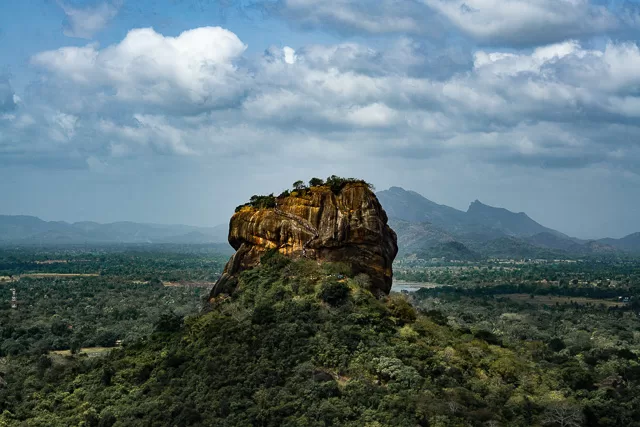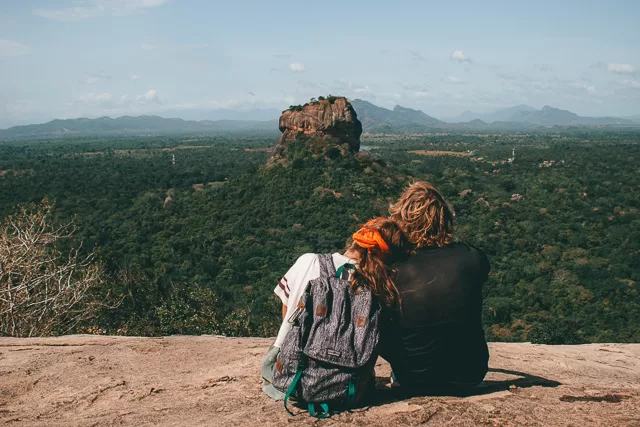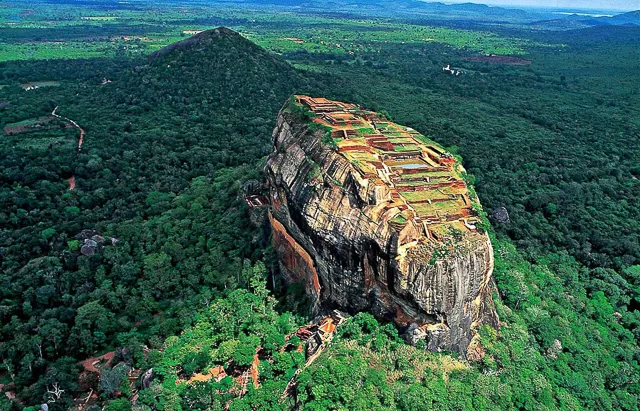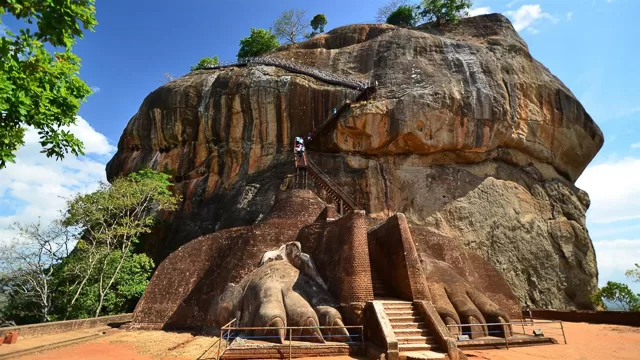About
Top Experiences
Type of Journey
Subscribe to newsletter and stay updated
Read about our travel expeditions, new destinations, new pictures, latest trip schedules
Sigiriya rock fortress is one of the most popular tourist destinations in Sri Lanka, and for good reasons too. Located around 370 meters above sea level, this fortress was formed through advanced technological tactics and creative human imagination.
Sigiriya rock fortress is made up of an extinct volcano’s magma and consists of half-ruined fortifications, canals, ponds, alleys, canals, and fountains. Even though Sigiriya rock fortress has been destroyed, it still stands as majestic as ever. Shaped like a lion, Sigiriya lion rock attracts tourists from far and wide, who come all the way, to pay reverence to its archaeological and architectural importance.
The beauty of this fortress lies in the fact that it is riddled with terrace gardens, cave gardens, boulder gardens, and water gardens- some of the oldest in the entire world. The walls depict the female form and pay homage to feminine beauty. The Mirror Wall also lends aesthetic value to the fortress. It is believed that in earlier times, the Wall would be kept as polished as possible, and the king could see his reflection in it. Today, the wall is covered with inscriptions or messages left behind by tourists from an older age. All of these have been preserved to depict the history of Sigiriya rock.
The landscape provides a mesmerizing view, nestled between lush greenery. Even though it’s usually packed with people, you’ll find moments of tranquillity and solace.
OVERVIEW
Location: North Matale District
Nearest Airport: Colombo
How to reach: by air/road
Famous for: Sigiriya Rock Fortress
Best time to visit: June to September
WHAT TO SEE
Sigiriya Rock Fortress
Sigiriya Rock Fortress
History- Earlier a donation made by Buddhist devotees, the Sigiriya rock formation was transformed into a formidable fortress by King Kassapa. He employed extremely skilled architects and workers, who gave it the shape of a majestic lion. Humans first occupied Sigiriya in the Mesolithic Period, and since then, Sigiriya has seen an ever-changing wave of people and inhabitants. After King Kassapa died, this fortress was once again made into a monastery for Buddhist devotees. The Sigiriya rock fortress has seen some tragic tales unfolding within its walls. Kassapa and Moggallana were the two brothers of the royal family. Kassapa deceived his elder brother and took control over the throne. Mogallana was forced to flee from his rightful kingdom. Fearing that his brother may launch an attack sooner or later, Kassapa shifted his royal capital from Anuradhapura to central Sri Lanka. This is howSigiriya lion rock came into being; King Kassapa wanted to build his fortress at a high place so that he would have the strategic advantage in a battle. But karma took over Kassapa’s fate as Mogallana launched a fearsome counter-attack to regain his rightful throne. Kassapa was slain by his own brother’s army, and with that, the fortress was destroyed. Soon it was converted into the monastery it once was. Later, the complex was abandoned by monks as well, and it turned into a desolate, lonely building. It was in 1831 that the fortress complex caught the eyes of Europeans, and the rest, as they say, is history!

Structure- The name “Sigiriya” itself is a representation of the lion-shaped stone that has attracted many since its establishment. The Lion itself has been destroyed, but its claws remain. These claws are visible in the form of the paws of the Lion surrounded by masonry walls. Earlier, the entrance was adorned by Lion’s mouth, with the main staircase leading right into it. The main parts of Sigiriya include the frescoes, the Mirror Wall, and the Gardens. The frescoes consist of enchanting paintings of women. Most of these paintings represented the King’s wives, concubines, or the celestial Apsaras. Once the complex was restored as a place for Buddhist devotees, most of the paintings had to be covered or removed, lest they may prove to be a distraction for the monks who vow celibacy. The porcelain Mirror Wall used to be a matter of pride for the King. It would be polished so thoroughly that when the King passed the wall, along with his followers, he would puff his chest and look at his reflection on the Wall. It’s now covered with lovely inscriptions and poems left behind by visitors from as early as the 8th Century. Extensive excavations at the site have brought out many gardens, parks, and old frescoes in the western part of the complex. These frescoes are around 1500 years old! The gardens are some of the oldest known gardens in the world; they are maintained through underground water pumps and hydraulic systems. The cleverly crafted structures and meticulous design are a result of ingenious engineering skills.

Where to Stay
Create everlasting memories under the shade of towering trees, as you spend your leisure time in Amaya Signature Kandalama hotel. Located on the banks of Kandalama Lake, this hotel will amp up the entire feel of your vacation.

Aliya Resort and Spa set the benchmark for hospitality and extravagance. The lush greens, rolling fields and indigenous trees surrounding the Resort add on to its ethereal beauty.
Heritance Kandalamabrings out an international appeal; let Heritance indulge you in the most lavish way. Set against a green backdrop, with the blues of a nearby lake, you’re going to feel cherished and at peace.
Amaya Lake Kandalama Hotel will show you the best sides of traditional Sri Lankan culture and cuisine. You’ll be blown away by their rustic and serene ambience.

Both the Jetwing Vil Uyana and Jetwing Lakepay homage to their ancestral and Sri Lankan history, in the form of their architecture and interior decor. Born from their agrarian past, they are strong believers of servitude and gratitude.
You’ll find your perfect accommodation right here in these wonderful hotels.